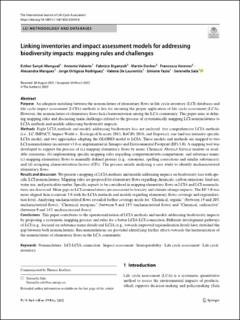| dc.description.abstract | Purpose
An adequate matching between the nomenclature of elementary flows in life cycle inventory (LCI) databases and life cycle impact assessment (LCIA) methods is key for ensuring the proper application of life cycle assessment (LCA). However, the nomenclature of elementary flows lacks harmonization among the LCA community. This paper aims at defining mapping rules and discussing main challenges related to the process of systematically mapping LCI nomenclatures to LCIA methods and models addressing biodiversity impacts.
Methods
Eight LCIA methods and models addressing biodiversity loss are analyzed: five comprehensive LCIA methods (i.e., LC-IMPACT, Impact World + , Ecological Scarcity 2013, ReCiPe 2016, and Stepwise), one land use intensity-specific LCIA model; and two approaches adapting the GLOBIO model to LCIA. These models and methods are mapped to two LCI nomenclatures (ecoinvent v3.6 as implemented in Simapro and Environmental Footprint (EF) 3.0). A mapping tool was developed to support the process of (a) mapping elementary flows by name, Chemical Abstract Service number or available synonyms; (b) implementing specific mapping rules regarding compartment/sub-compartment, and substance name; (c) mapping elementary flows to manually defined proxies (e.g., synonyms, spelling corrections and similar substances); and (d) assigning characterization factors (CFs). The process entails analyzing a case study to identify uncharacterized elementary flows.
Results and discussion
We present a mapping of LCIA methods and models addressing impacts on biodiversity loss with specific LCI nomenclatures. Mapping rules are proposed for elementary flows regarding chemicals, carbon emissions, land use, water use, and particulate matter. Specific aspects to be considered in mapping elementary flows in LCIA and LCI nomenclatures are discussed. Main gaps in LCI nomenclatures are associated to toxicity and climate change impacts. The EF 3.0 was more aligned than ecoinvent 3.6 with the LCIA methods and models regarding elementary flows coverage and regionalization level. Analyzing uncharacterized flows revealed further coverage needs for “Chemical, organic” (between 19 and 20% uncharacterized flows), “Chemical, inorganic” (between 9 and 18% uncharacterized flows) and “Chemical, radioactive” (between 9 and 14% uncharacterized flows).
Conclusions
This paper contributes to the operationalization of LCIA methods and models addressing biodiversity impacts by proposing a systematic mapping process and rules for a better LCIA-LCI connection. Different development pathways of LCI (e.g., focused on substance name detail) and LCIA (e.g., towards improved regionalization level) have stretched the gap between both nomenclatures. Recommendations are provided identifying further efforts towards the harmonization of the nomenclature of elementary flows in the LCA community. | en_US |

